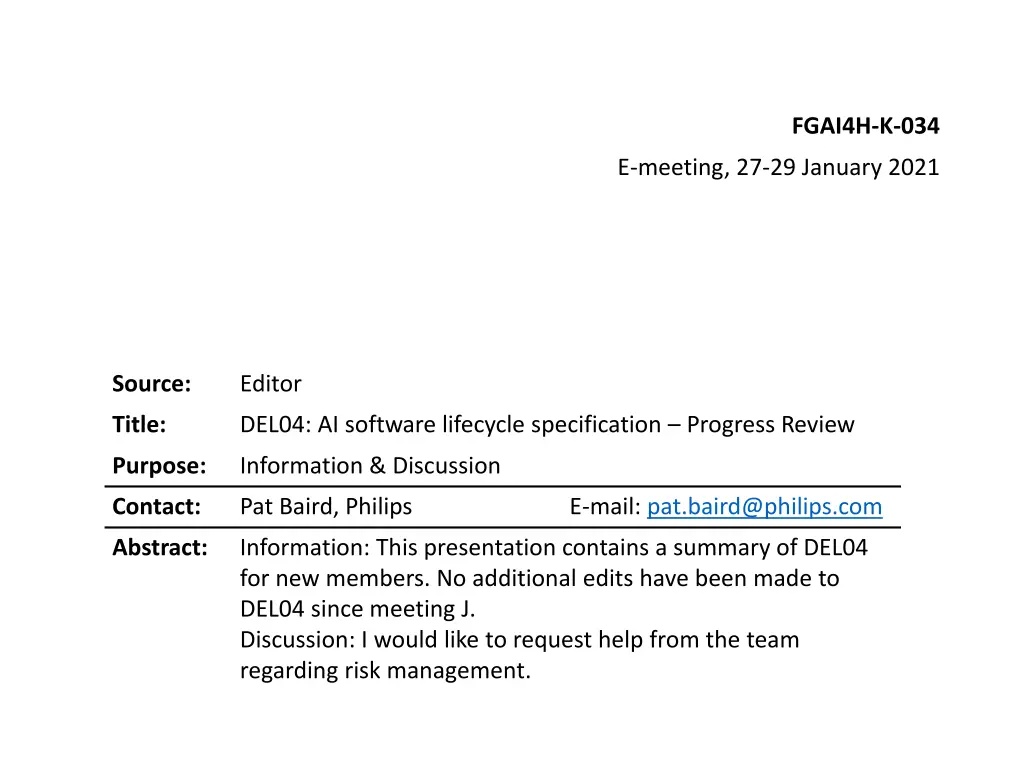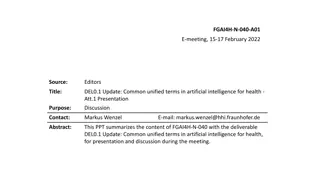
Software Lifecycle Specification for Healthcare AI Development
Explore the DEL04 AI software lifecycle specification, outlining the existing software development standards for healthcare AI applications. Learn about the ISO/IEC 62304 standard, the evolving ISO/IEC 82304-1 additions, and the critical lifecycle steps and risk management aspects involved. Discover how these standards ensure quality and compliance in medical device software development.
Download Presentation

Please find below an Image/Link to download the presentation.
The content on the website is provided AS IS for your information and personal use only. It may not be sold, licensed, or shared on other websites without obtaining consent from the author. If you encounter any issues during the download, it is possible that the publisher has removed the file from their server.
You are allowed to download the files provided on this website for personal or commercial use, subject to the condition that they are used lawfully. All files are the property of their respective owners.
The content on the website is provided AS IS for your information and personal use only. It may not be sold, licensed, or shared on other websites without obtaining consent from the author.
E N D
Presentation Transcript
FGAI4H-K-034 E-meeting, 27-29 January 2021 Source: Editor Title: DEL04: AI software lifecycle specification Progress Review Purpose: Information & Discussion Contact: Pat Baird, Philips E-mail: pat.baird@philips.com Abstract: Information: This presentation contains a summary of DEL04 for new members. No additional edits have been made to DEL04 since meeting J. Discussion: I would like to request help from the team regarding risk management.
DEL04: AI software lifecycle specification Provides a summary of existing software development lifecycle standards and how they could be applied for healthcare AI. Intended audience includes people that may not be familiar with regulated healthcare environment and the applicable standards for software. Includes supplemental suggestions from Xavier Health project that was focused on the product development lifecycle.
Customer needs satisfied The primary standard for medical device software development is ISO/IEC 62304, and it has this lifecycle diagram Activities outside the scope of IEC 62304 Customer needs SYSTEM development ACTIVITIES (including RISKMANAGEMENT) 7 Software RISKMANAGEMENT 5.1 5.4 5.2 5.3 However, this standard was written when a software for a medical device was just one component of the entire product, and 62304 assumes that product-level testing is handled by another standard 5.8 5.6 5.7 Software development planning Software detailed design 5.5 Software requirements analysis Software architectural design Software release for VALIDATION Software integration and integration testing Software SYSTEMtesting Software UNIT implementation 8 Software configuration management 9 Software problem resolution So ISO/IEC 82304-1 was developed to include process steps like the intended use, validation that the product meets the intended use, post-market monitoring, etc. However, there are still some additional factors; these have been identified in the Xavier work.
Lifecycle steps & references SOFTWARE SYSTEM TESTING ([62304], [XAVIER]) ESTABLISH INTENDED USE ([82304-1]) PERFORM INITIAL RISK ASSESSMENT ([82304-1]) ESTABLISH USE REQUIREMENTS ([82304-1]) ESTABLISH SYSTEM REQUIREMENTS ([82304-1]) CREATE SOFTWARE PLAN(S) ([62304], [XAVIER]) SOFTWARE REQUIREMENTS ([62304], [XAVIER]) SOFTWARE ARCHITECTURE ([62304], [XAVIER]) SOFTWARE DETAILED DESIGN ([62304], [XAVIER]) SOFTWARE INTEGRATION, UNIT-LEVEL, INCLUDING TESTING ([62304], [XAVIER]) SOFTWARE INTEGRATION, INTEGRATION LEVEL, INCLUDING TESTING ([62304], [XAVIER]) SOFTWARE RELEASE ([62304], [XAVIER]) ESTABLISH VALIDATION PLAN ([82304-1]) VALIDATE THE PRODUCT ([82304-1]) CREATE VALIDATION REPORT ([82304-1]) MONITOR PRODUCT PERFORMANCE ([82304-1], [XAVIER]) MAINTAIN SOFTWARE AFTER LAUNCH ([82304-1]) RETIREMENT ([82304-1]) RISK MANAGEMENT (CONTINUOUS) ([82304-1], [XAVIER]) CHANGE CONTROL / PROBLEM RESOLUTION (CONTINUOUS) ([62304], [XAVIER]) CONFIGURATION MANAGEMENT (CONTINUOUS) ([62304], [XAVIER])
References: IEC 62304:2006, Medical device software: software lifecycle process. https://webstore.iec.ch/publication/6792 Note that 62304 is in the process of being updated; I expect there to be a 2021 version released in the next few months. IEC 82304-1:2016, Health software Part 1: General requirements for product safety. https://www.iso.org/standard/59543.html Xavier Health, Perspectives and Good Practices for AI and Continuously Learning Systems in Healthcare, August 2018, https://www.advamed.org/sites/default/files/resource/perspectives_and_good_p ractices_for_ai_and_continuous_learning_systems_in_healthcare.pdf (visited 2020-06-08)
New Thought!! Risk Management? Risk Management & patient safety are obviously important in healthcare. There are already existing standards regarding the risk management process for healthcare, and there are standards for risk management of software, but ML systems can fail in unique ways that people might not think about. We (members of standards organizations) are starting a risk management standard to close this gap. We are reaching out to experts that we know. It occurs to me that FGAI4H has many experts with experience in this field I would love any input that team members would have regarding how ML fails & what mitigations you ve put in place.
Questions.. What process / what means are available to collect wisdom from our subject matter experts? Although originally intended to help accelerate the creation of an international standard, does the FGAI4H team want a deliverable? Perhaps a checklist of risks to consider when developing (and evaluating) a ML application?

